I’ve been trying out five different options for working caterpillar tracks, since making them function would be awesome and fake ones with rollers (usually) look terrible. I’ve found various homemade excavators, tanks, bulldozers, cranes and other models with real tracks and a plenty of techniques to achieve them, including: bath rugs, inner tubes, individual links, rubber sheet strips, timing belts and even just corrugated cardboard (both for the treads and the inner teeth). Likewise, it seems neither the tracks or the hubs (necessarily) need inner teeth - except for keeping the tracks in place - and some designs work fine without them. Two of the methods I’ve tried use superglue to join the ends and stay together better than I expected.
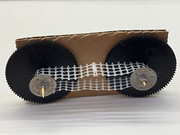
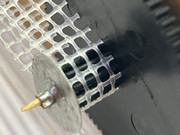
Option 1: silicone anti-slip net (IKEA STOPP). As mentioned when I made the skid-steer loader and used the net for the cab sides, it can mesh with the teeth on my gears and is also easy to cut with precision. After cutting one strip and supergluing the ends, I made a cardboard test frame with two large gears and stretched it between their side portions. Because it ‘is’ a form of rubber, I’m not entirely surprised it works. Even though the seam is solid where the gears engage in the middle, it never gets stuck and just happens to fall between the teeth. There’s also significantly less friction compared to the methods below, but that’s only because the large parts of the gears make contact with the ground. Despite being stretched all the way, it still sags in the middle and might need rollers (or other supports) if used on a finished model. It would likely not be strong enough to touch the ground without an extra layer and may not have the traction required for most surfaces. Unless the tracks could still be in the air, but fitted to much smaller sprockets to make them appear lower. Demos: on ground; in air
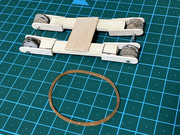
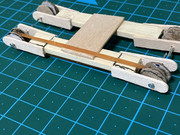
Option 2: rubber bands. I would (obviously) use much thicker bands if I were to go with this method, but I just wanted to see how it performs. I built an excavator-like wooden test chassis with cardboard “sprockets” (hubs) and fitted the band around them, making sure they wouldn’t be able to move sideways like my usual wheelsets. Due to how thin this band was, it didn’t quite fit the bill because the chassis was still on its hubs and could only grip a few surfaces due to the added friction (which would’ve persisted even with thicker bands). Demos: on ground; in air
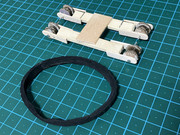
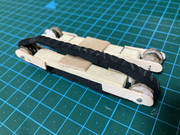
Option 3: foam flip-flop soles. Inspired by the tyres on ManualdoMotorStirling’s RC chassis, I once cut up the foam soles of an old, worn-out pair of flip-flops and kept their remains in a bag of random materials for potential uses. It had me wondering what might happen if I’d cut thin strips from them and glue the ends. Indeed, they were found to be sufficiently elastic for this and nearly on-par with other forms of rubber. Since they already have their own treads and can grip literally anything, they would very likely be the most effective option I’ve tried so far. The only issues I ran into are that they tend to get twisted and keep slipping off, I couldn’t keep the same thickness for the entire length as they were tricky to cut, and they didn’t seem tight enough even though I cut/glued them shorter than the wheelbase. Regardless, it seems they have the potential to work flawlessly. Demo
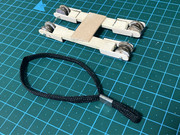
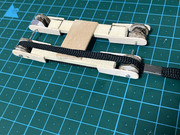
Option 4: shoelace-like cord of an unknown origin (possibly from a handheld product that had a strap). While it ‘was’ thicker than the rubber band, it did have the same traction problem despite reaching the bottom at all times. I kept the metal fastener since I was unsure whether I’d use the lace and didn’t want to cut and glue it. The tread isn’t as good as the ones on the flip-flop sole tracks, though I could always add custom treads over them. Demo
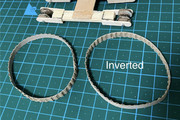
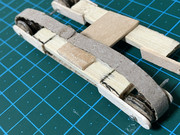
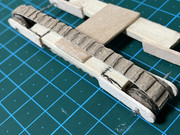
Option 5: Corrugated cardboard strips (tread on outside or inside). Although I’ve seen proof it can work, I didn’t trust it too much compared to the other options but still wanted to try it as well. Oddly, my regular glue was able to keep them together as firmly as the superglued materials and did not affect their elasticity. I made one track with the tread on the outside and another inverted to see which performed better; turned out what I said earlier about the need for sprockets and inner teeth was debatable. The one with the inner tread had somewhat better grip on other surfaces besides the cutting mat, likely because the teeth gripped the hubs more effectively despite the (current) lack of an outer tread. Gluing inner teeth on the other track and even strengthening the tread with toothpicks didn’t enhance the grip and in fact made it too rigid. I’ve determined the reason why both kept slipping off was because the rough edges on the inner grooves of the hubs were moving them sideways - a bit like how some types of reels are built to move a hose, wire, etc. to the side during winding. I could try building smoother hubs from something like perler beads to prevent this. Demos: inner tread; outer tread
One other option I’m considering is cutting good old zip ties (or strips of another material) and linking them using string, possibly with inner teeth so the tracks could lock into grooved hubs.